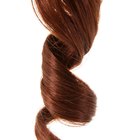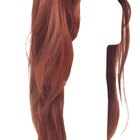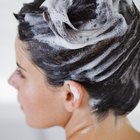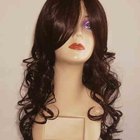Styling and caring for your synthetic wig is a learning experience, leading to questions of what type of product to use, and whether or not wig-specific products make a difference. These days, there are many options for synthetic wigs and products, so you need not resort to risking the quality of your fibers by using mousse and other products that are not designed with synthetic wigs in mind.
Hair Mousse Basics
hair mousse, also known as styling foam, is a lightweight foam product released from a pressurized canister. Mousse is commonly used to define curl patterns through a light, non-stick hold. It can also be used in the roots of fine hair for a temporary increase in volume.
Hair mousse products are created for a variety of styling methods, some of which involve heating tools, and some allow for air-drying. Each brand and type of mousse has different chemical additives, though many contain ethanol alcohol and silicone. This chemical composition can be damaging to hair, leading to dryness and brittle hair shafts.
Synthetic Fiber Wigs
Synthetic wigs come in varying degrees of acrylic fiber, with an obvious quality-to-price correlation. For example, synthetic costume wigs are often the cheapest around, and typically last through one or two uses before becoming unmanageable. At the other end of the spectrum, high-quality "designer" synthetic wigs are created for long-term everyday wear.
Synthetic acrylic fibers are sensitive to chemicals as well as heat, and it is recommended to avoid exposing your wig to high temperatures (above 160 degrees), or the fibers can melt and "frizz," irreparably ruining the style of the wig.
Some high-quality wig lines, such as Henry Margu Wigs, blend synthetic fibers with human hair for a more natural, touchable look, while other manufacturers have introduced protein-based synthetic fibers, which are capable of withstanding temperatures up to 350 degrees.
Synthetic Wig Warnings
At first glance, it would appear that the damage to human hair sustained by the chemical composition of hair mousse does not apply to synthetic fiber wigs. However, most synthetic fiber wigs are not made to withstand the heat styling that accompanies usage of hair product such as mousse, nor are some lower-quality fibers able to withstand the chemical interactions that are possible with these products.
For example, alcohol will eventually dissolve an acrylic material after prolonged or repeated applications, which is commonly noted when working with acrylic fingernails. As the majority of styling products, including mousse, contain alcohol, products created for human hair are best to be avoided when styling your synthetic wig.
Synthetic Wig Styling
Many synthetic wigs on the market are designed to be worn as a specific style, with a cap construction to match. Whereas mousse is used as a volumizing product on human hair, a synthetic wig will often have a cap construction that creates volume in the crown or rear of the cut. Sleek wigs will not benefit from the use of volumizers, as they are designed to lay smoothly at the cap.
Overall, many wigs are "wash and go" in style, and can be refreshed with a spritz of water in between washes. If you would like to add a curl pattern or definition to your wig, the texture can be manipulated with steam products, such as the classic Conair steam curlers.
Synthetic Wig Products and Care
Many wig manufacturers provide products to accompany your synthetic wig purchase, from shampoo and conditioner, to basic comb-through detanglers. Henry Margu, Brandywine and HairUWear are some of the most prominent synthetic products providers.
How often you shampoo your wig depends on your environment and your level of physical activity while wearing your wig, as well as how often you plan to wear it. Many manufacturers provide detailed instructions with their products.
If you have made an investment in your synthetic wig, you may also want to look for a local wig specialist for trimming, serious detangling and other wig needs. Wig specialists often work with steam tools, and without using damaging levels of heat. Like a regular stylist, wig specialists are often available by appointment, and offer a variety of services to refresh your look and help you present your best self.
Related Articles

How to Style a Kanekalon Wig

How to Keep Synthetic Wigs From ...

How to Fix Dry Ends on a Synthethic Wig

How to Use Hot Rollers on a Wig

How to Get Frizz-Free Hair When Your ...

How to Take Care of a Wet & Wavy Weave

How to Keep Layered Hair Straight

The Difference Between Texturizing & ...

How to Maintain a Deep Wave Weave

How to Remove Hairspray From Wigs

How to Care for Kanekalon Extensions

How to Make Extensions Smooth & Silky ...

Types of Synthetic Hair

How Often Do I Have to Wash Synthetic ...

How to Keep Curly Wigs Nice

Serum Vs. Gel

How to Give Volume to Synthetic Wigs

What Is the Difference Between ...

How to Straighten Your Weave

How to Get a Healthy Spiral Perm
Writer Bio
Jennifer Van Leigh began writing short pieces in 2007. With over five years in the hair industry, Van Leigh has contributed articles at Atlanta Salon & Spa and is certified as an extensions stylist. She studied scriptwriting and creative nonfiction in Gallery 37, a Chicago youth arts program.